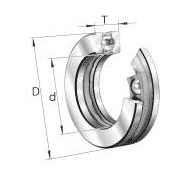Food-Grade Stainless Steel Bearings with Solid Lube
Leave a CommentIn sensitive food-grade applications and corrosive environments, selecting the proper bearings is critical for ensuring optimal system longevity and reliability. In these harsh settings, bearings must provide high performance and durability without the need for frequent maintenance or replacement.
Over the years, bearing manufacturers have developed a range of solutions designed to stand up to the general wear and tear inherent in applications involving constant exposure to corrosive elements or ongoing, high-pressure washdowns.
For instance, stainless steel bearings, solid lube, and seals and slingers can be used to create unique components that deliver high performance and a long life span while resisting bearing contamination.
Here at Action Bearing, we’re proud to offer NTN Sentinel Series stainless steel bearings, which are specifically designed for use in these food-grade settings.
Features and Benefits
Featuring food-grade solid lube and safety-forward covers, the NTN Sentinel Series bearing units are specifically designed to offer maintenance-free performance, reducing downtime and increasing cost savings.
NSF H1 food-safe solid lubricant eliminates the need for reapplication after installation and, because these bearings are washdown-resistant, they’re able to stand up easily to the constant cleaning required in hygiene-critical food and beverage applications.
A seal and slinger combination is used to create a washdown-resistant barrier, which also helps prevent bearing contamination, as does the 100%-stainless-steel bearing construction. Stainless steel also helps prevent chipping and corrosion, which can ultimately result in contamination from bearing part breakdown. Finally, protective covers provide an additional line of defense against moisture and contamination while helping to protect maintenance personnel.
Allowing for quick, simple installation, these bearings are an ideal replacement for existing, subpar bearing systems.
Understanding Food-Grade Solid Lube
A polymer product impregnated with food-safe oil, H1 food-safe solid lube can be used in temperatures ranging from 14°F to 212°F, allowing for use in many food applications. The oil is stored in a porous material that acts like a sponge, ensuring that only the required amount of base oil is released to lubricate components as they move. This allows for a continuous state of lubrication, extending bearing life and reducing the need for maintenance and replacements.
Since this food-grade lubricant is contained within the sponge-like cavities, it does not come into contact with the high-pressure washdowns that must be done regularly to eliminate contaminants; the H1 solid lube resists these washdowns easily, remaining intact and effective. Plus, the seal and slinger design removes the risk of lubricant leakage that would attract dust and dirt around the bearing.
Common Applications
In addition to serving as an ideal solution for food-grade applications, the NTN Sentinel Series is also well-suited to corrosive environments thanks to its unique seal and slinger design.
These bearings can be used in many sectors that involve direct or incidental contact with food, such as:
-
- Conveyors
- Bottling/canning
- Dairy processing
- Seafood and meat processing
- Cosmetics and pharmaceutical production
Sentinel bearings are especially well-suited to blending, stirring, separating, cooking, drying, packaging, and wrapping applications within these industries. Difficult-to-maintain or hard-to-access locations can also benefit from these bearings, since they do not require regular maintenance or replacement after initial installation
Learn More
For over 50 years, Action Bearing has been supplying industry-leading ball and roller bearings to OEM and maintenance markets throughout the world. In addition to the NTN Sentinel Series, we’re also proud to offer bearings from IPTCI, AMI, Link-Belt, and FYH, among many others.
Ready to get started on your next project? The expert team at Action will work with you to ensure you select the best bearing for your specific food-grade application. Reach out today to learn more about our food-grade and corrosion-resistant bearing options.

 Please visit Emersonbearing.com for our latest blogs and updates!
Please visit Emersonbearing.com for our latest blogs and updates! These components are typically used in applications requiring the use of
These components are typically used in applications requiring the use of  When choosing a cam follower, there are many options to consider based on what sort of job they’ll be used for and the specific weights and speeds required. The two major types are yoke rollers and stud rollers.
When choosing a cam follower, there are many options to consider based on what sort of job they’ll be used for and the specific weights and speeds required. The two major types are yoke rollers and stud rollers.  Prior to universal quality standards, the production process for
Prior to universal quality standards, the production process for  Rapid speed changes occur across a broad array of industrial applications, from wood milling machines and reversible blooming mills to motor vehicle clutches and beyond. Almost all machinery and various types of motors undergo speed changes at some point during manufacturing processes. Results of such
Rapid speed changes occur across a broad array of industrial applications, from wood milling machines and reversible blooming mills to motor vehicle clutches and beyond. Almost all machinery and various types of motors undergo speed changes at some point during manufacturing processes. Results of such